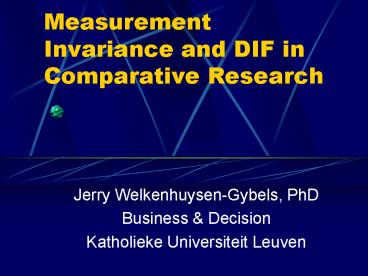Measurement Invariance and DIF in Comparative Research - PowerPoint PPT Presentation
1 / 12
Title:
Measurement Invariance and DIF in Comparative Research
Description:
What is DIF? ... Mantel-Haenszel statistic has highest power for the detection of uniform DIF ... DIF detection across (much) more than two groups have received ... – PowerPoint PPT presentation
Number of Views:108
Avg rating:3.0/5.0
Title: Measurement Invariance and DIF in Comparative Research
1
Measurement Invariance and DIF in Comparative
Research
- Jerry Welkenhuysen-Gybels, PhD
- Business Decision
- Katholieke Universiteit Leuven
2
What is DIF?
- Observation Mean of group A on item I (indicator
of latent trait W) different from mean of group B - Interpretation Group A and B differ with respect
to the latent trait W
3
What is DIF? (Continued)
- If interpretation is correct, then controlling
for W (matching criterion) should remove
relationship between group variable and item
score - Conclusion Item is measurement invariant across
the groups
Item I
Trait W
Group
4
What is DIF? (Continued)
- If relationship between group and item remains
after controlling for the latent trait W, then
Differential Item Functioning (DIF) - Interpretation Item measures something in
addition to W that is differentially related to
the group variable
Item I
Trait W
Group
5
DIF example
- Question from Scholastic Aptitude Test (SAT)
- Decoy relates to Duck as
- Spider to Web
- Lure to Fish
- Lasso to Rope
- Net to Butterfly
- Boys and girls with same verbal ability level had
different probabilities of answering the question
correctly - Answering the question also requires knowledge of
hunting and fishing
6
DIF detection techniques
- Nonparametric no assumption about the functional
form of the relationship between latent trait W
and item score - Observed/latent variable Is W treated as a
latent variable or as and observed variable
(calculated as the sum of the item scores)
7
Observed - Parametric
- Cumulative logit model
Uniform DIF
Nonuniform DIF
8
Latent - Parametric
- Cumulative logit model with random effect
9
Observed - Nonparametric
- Mantel-Haenszel statistic
- Calculates the association between I an group (on
the basis of a ij partial contingency table) at
each level w of W and sums across the levels of W - Can only detect uniform DIF
10
Use in substantive research
- Cumulative logit model (with random effect) has
high power to detect any kind of DIF (but also
inflated type I error rate), also if parametric
assumption is not met - Mantel-Haenszel statistic has highest power for
the detection of uniform DIF
11
Issues for future research
- Observation In international research strict
equivalence is difficult to obtain - Comments
- More attention to scale construction
- Is strict equivalence necessary?
- Comparison of means Yes
- Use of item/scale as response or explanatory
variable and interest in size of coefficient
absence of uniform DIF suffices - Use of item/scale as response or explanatory
variable and interest in direction of
coefficient item I needs to be significantly
related to W and in the same direction across the
groups
12
Issues for future research (Continued)
- Simulation studies show that the performance of
DIF detection techniques decreases when W
distributions of groups differ - Techniques with either inflated type I error or
low power - DIF detection across (much) more than two groups
have received few attention































